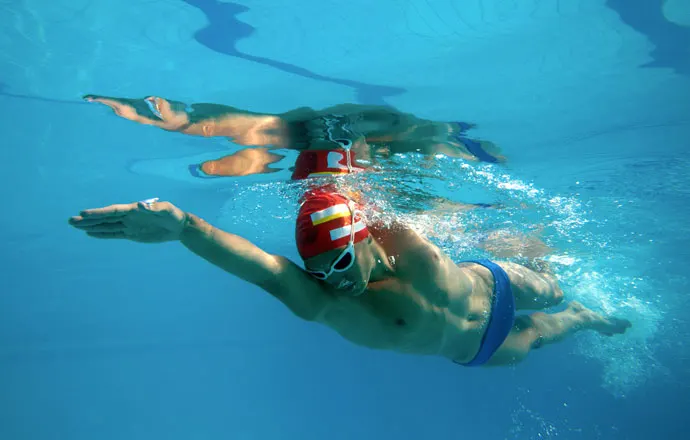To swim front crawl / freestyle with the greatest efficiency and prevent neck injuries, you need to properly position your head and roll your body.
This article explains the correct swimming technique to be able to do this.

Use a Neutral Head Position
In the past, it was often advised to lift the head up and to look forward while swimming front crawl.
The idea is that by lifting the head higher up in the water, less drag is created resulting in faster swimming times.
However, there are two problems with that approach:
1) Your hips and legs often have the tendency to drop when you lift your head up.
As a consequence, you create more drag instead of less. Furthermore, you need to kick harder to keep your hips and legs up.
2) If you look forward at all times while swimming front crawl, you put your neck in an awkward position which can lead to neck injuries over the course of several years.
So, in my opinion, it is best to keep your head in line with your trunk in a neutral position and look straight down.
This helps you to keep your body horizontal in the water, creates the least amount of drag and also prevents neck injuries.
Please note that it may still be necessary to look forward from time to time to avoid obstacles or to orient yourself. As long as you keep this to a minimum this shouldn’t be a problem.
An alternative is to look slightly forward from the corners of your eyes while keeping your head in a neutral position.
Be Balanced and Roll Your Body
While you swim front crawl, you should aim to keep your body as horizontal as possible in the water. This is called being balanced.
When you are balanced you will create the least amount of drag. And as explained above, a correct head position has a big influence on your balance.
When you swim front crawl, you should let your body roll freely from side to side, following the movements of your arms.
Swimmers often have the tendency to roll too little rather than too much.
Rolling from side to side allows you to engage large muscle groups (chest, back, abs in addition to shoulders and legs) and to consequently improve your propulsion.
While your body rolls from side to side, your head should remain static, looking straight down, except when breathing, as described next.
Roll to Breathe
To breathe in, you roll farther on your side than during the non-breathing arm strokes.
Your head simply follows along your body then rolls a little bit farther until your mouth clears the water so you can inhale.
You should roll your head as little as is needed because rolling too much can also disrupt balance and strain your neck.
In fact, if you watch the pros swim, you will see that they inhale with their mouth slightly to the side and in the trough of the bow wave created by their head, so that they need to rotate their head as little as possible.
While they do this, typically one lens of their swimming goggles is underwater and one lens above water. However, being able to do this takes a lot of practice.
A common error less experienced swimmers do is that they lift their head first before they roll on their side to breathe.
As explained above, this disrupts balance and causes their hips and legs to drop, increasing drag.
How to Become Balanced in the Water
It should now be obvious that being balanced in the water is an essential front crawl skill.
If you are balanced, you will be able to relax, roll with ease and swim more efficiently.
The first few of our swimming drills to learn the front crawl can teach you this important skill if you still have problems with this aspect of your swimming technique.
Related Pages
You may also be interested in the following articles that cover the front crawl’s swimming technique:

Scott Welk
Friday 18th of January 2019
I don’t exhale through my nose. Never have as far as I know. Isn’t that common?
Now I wear a nose clip to keep the water (chlorine?) from irritating it after swimming for the next 6-8 hours.